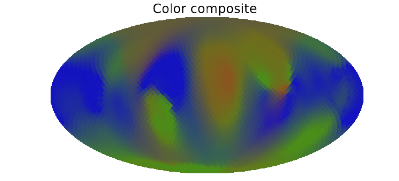
Image Retrieval of Earth-like Planets
1. How can we take a spatially resolved image of an Earth-like planet ?
It will be important to understand the environment of the planetary surface of habitable exoplanets, in other words, the habitat of exoplanets. Diverse surface environments on the Earth including continents, ocean, and meteorological condition serve as the backbone of biodiversity. One of the promising approaches to knowing the landscape of the terrestrial exoplanets is to identify surface components using the scattered light of the planets through the direct imaging observations.
However, even nearby Earth-like planets are small (Figure 1). Using a lot of space telescopes (for instance, 150 x 3m aperture), as proposed by Labeyrie (1999), is one possibility to resolve nearby exoplanets.

Figure 1. Apparent size of a nearby Earth-like exoplanet.
Even if one cannot resolve the planet, scattered light curve from the Earth-like planet itself contains information on the habitat on the planetary surface, such as clouds, soil, ocean, and vegetation since they have different reflectivity. Our aim is to develop an inversion technique of annual scattered light curves to sketch a two-dimensional albedo map of exoplanets, which will enable us to resolve the planet indirectly with a single space telescope.

Figure 2. Reflectivity of surface components on the Earth.
2. Spin-Orbit Tomography: Inversion Technique of the Planetary Surface from Disk-integrated Light Curve
Reflection light from a planet depends on the albedo of the visible and illuminated region of the planetary surface, which changes according to a spin rotation and orbital revolution.
Using this fact, we developed the inversion method to map the reflectivity from the scattered light curve. Since we use a diurnal and annual variation of the scattered light, we call our method Spin-Orbit Tomography (SOT). Even for a low-oblique planet like the Earth, the SOT can reconstruct the continental distribution if statistics is enough. For instance, half year observation of the Earth twin @10pc with a 10-15 m space telescope will give a high-quality map of the surface.
Visit https://github.com/HajimeKawahara/sot/wiki for more details.

Figure 3. The latest version of the global map of sol d (Earth), using real time-series of the Earth blue dot, as observed DSCOVR (Kuwata et al).
References
[1] Global Mapping of Earth-like Exoplanets from Scattered Light Curves
[2] Mapping Clouds and Terrain of Earth-like Planets from Photometric Variability : Demonstration with Planets in Face-on Orbits
[3]Mapping Earth-analogs from Photometric Variability: Spin-Orbit Tomography for Planets in Inclined Orbits
[4] Frequency Modulation of Directly Imaged Exoplanets: Geometric Effect as a Probe of Planetary Obliquity
Hajime Kawahara, ApJ 822, 112 (2016), arXiv:1603.02898,
[5] Global Mapping of an Exo-Earth using Sparse Modeling
Masataka Aizawa, Hajime Kawahara, Siteng Fan, ApJ 896 22 (2020) arXiv:2004.03941,
[6] Global Mapping of the Surface Composition on an Exo-Earth using Color Variability
Hajime Kawahara, ApJ 894 58 (2020), arXiv:2004.03931,
[7] Obliquity of an Earth-like planet from frequency modulation of its direct imaged lightcurve: mock analysis from general circulation model simulation
Yuta Nakagawa, Takanori Kodama, Masaki Ishiwatari, Hajime Kawahara, Yasushi Suto, Yoshiyuki O. Takahashi, George L. Hashimoto, Kiyoshi Kuramoto, Kensuke Nakajima, Shin-ichi Takehiro, Yoshi-Yuki Hayashi, ApJ accepted, arXiv:2006.11437,
[8] Bayesian Dynamic Mapping of an Exo-Earth from Photometric Variability
Hajime Kawahara, Kento Masuda, ApJ accepted, arXiv:2007.13096,
[9] Global Mapping of Surface Composition on an Exo-Earth Using Sparse Modeling
Atsuki Kuwata, Hajime Kawahara, Masataka Aizawa, Takayuki Kotani, Motohide Tamura arXiv:2204.01996, Accepted by ApJ (2022)